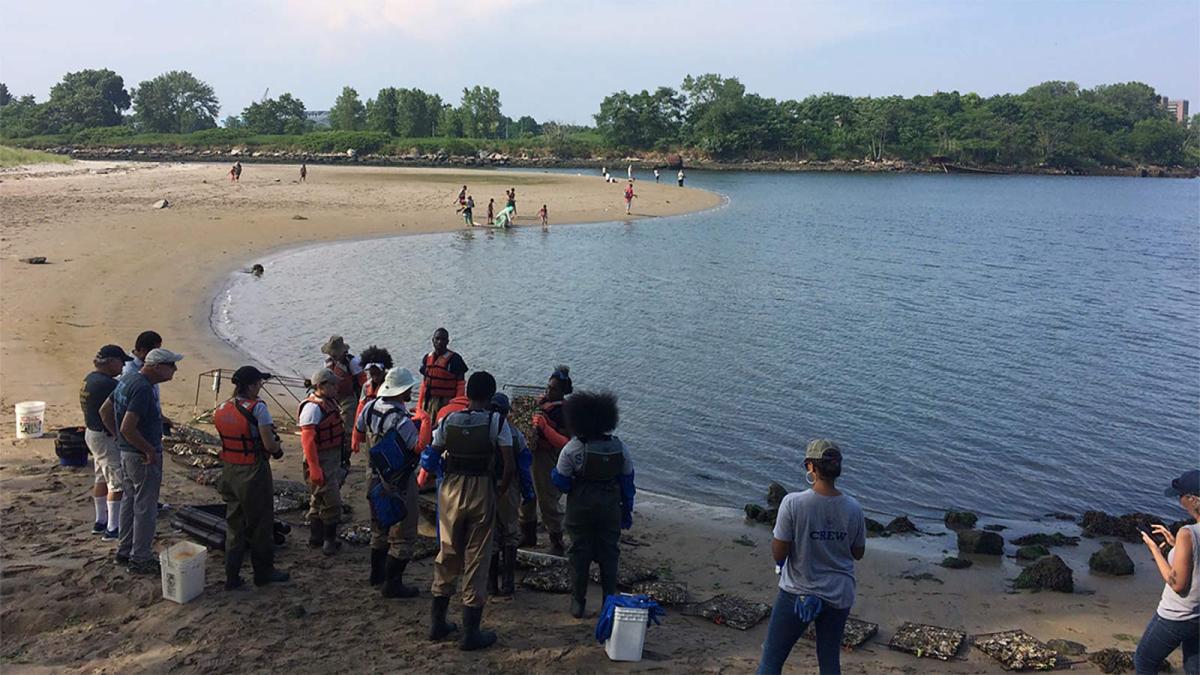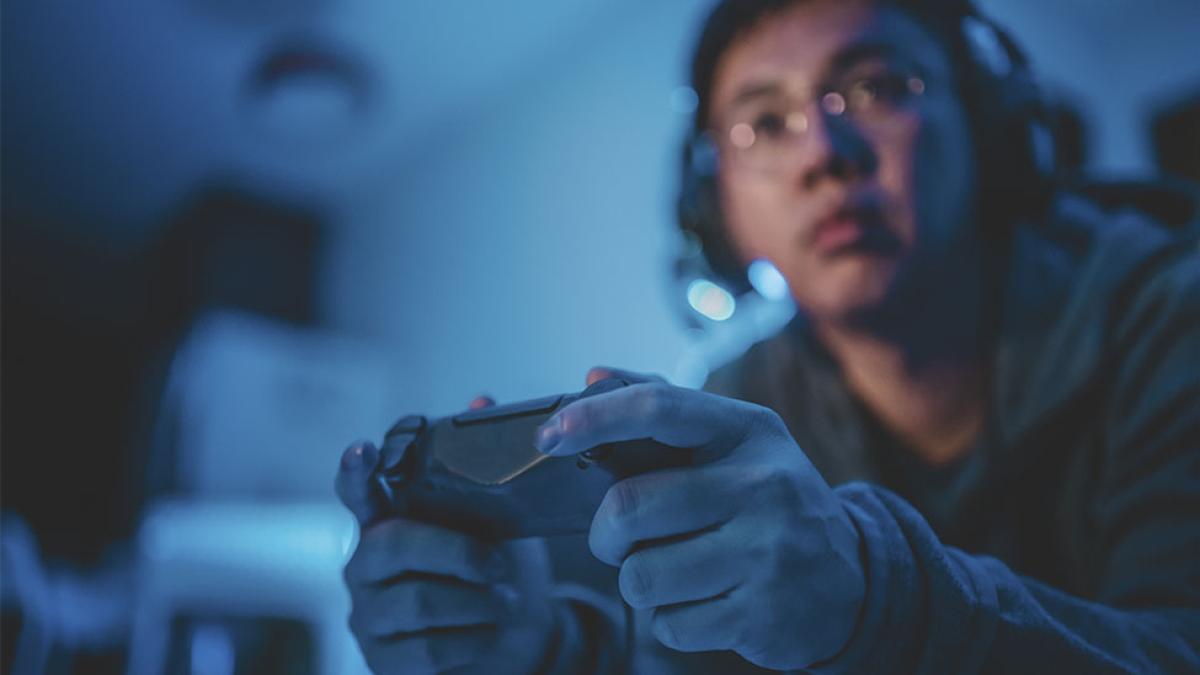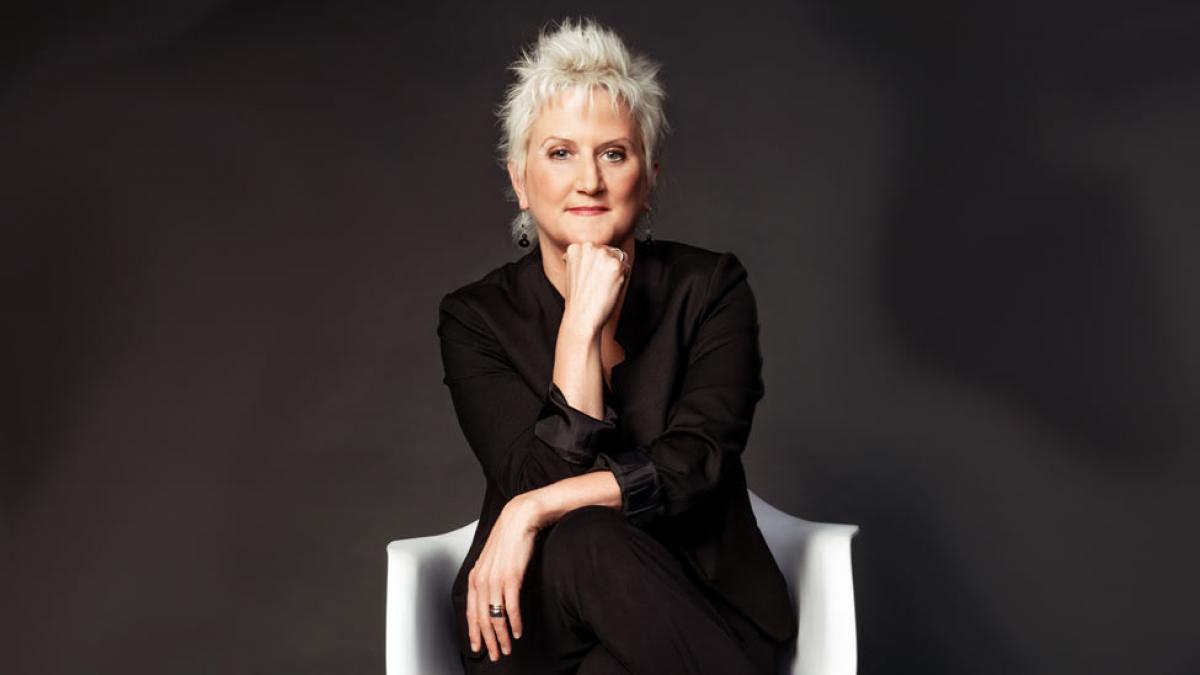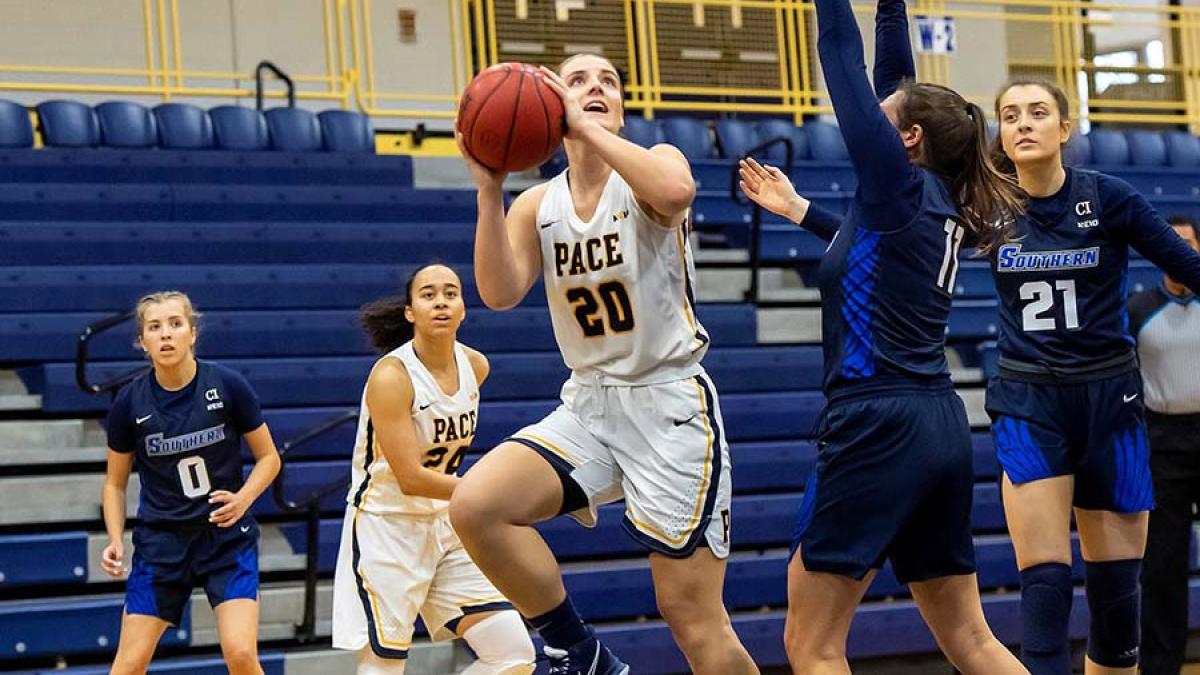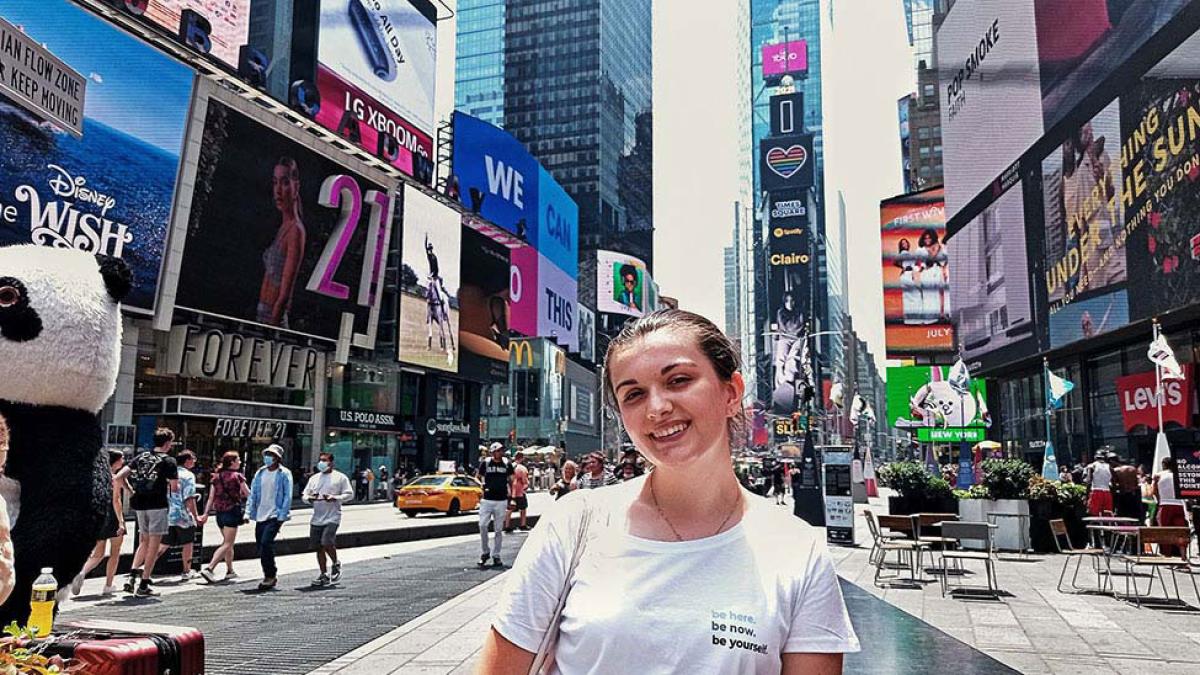
The Trash You Can't See
Through Digital Trash, an augmented reality art exhibit, Professor Will Pappenheimer and his mobile media students are elucidating an often-unseen problem in a truly innovative way.

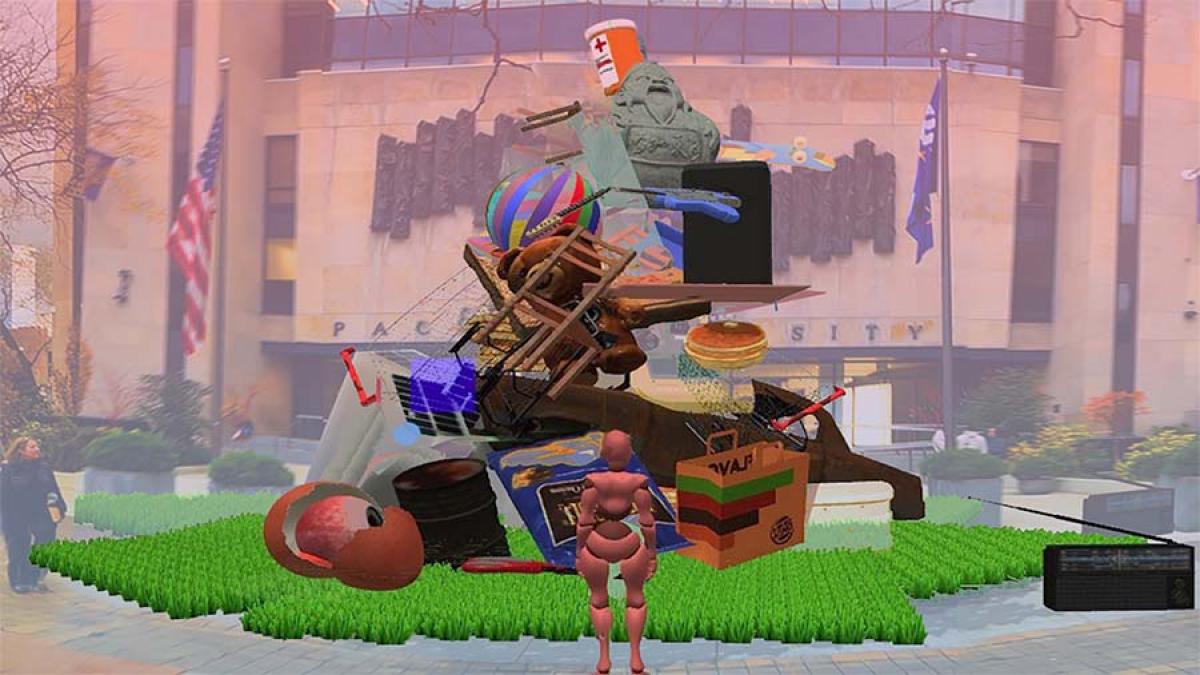
We often think of trash as something physical; we put garbage in a bin, that bin gets collected, and the cycle continues. When it comes to large-scale environmental problems, we might think of oil spills, reef decimation, or hazardous agricultural practices. In 2022 however, there is another, increasingly relevant type of trash that is accumulating by the nanosecond.
"There's a lot of invisible things about technology,” says Dyson Art Professor Will Pappenheimer, a pioneer in the use of augmented reality (AR) as an artistic medium. “We are calling attention to the idea that digital trash is not completely without cost."
This reality—that the files stored on our computers and servers aren’t entirely without environmental impact—was the idea behind Digital Trash, an exhibit recently showcased at the Pace Art Gallery. The exhibit was conceived and created by students in Pappenheimer’s ART 288 Mobile Media course, a class that requires students to imagine New York City a canvas and their phones as a window into a new dimension.
Yet, this was no ordinary exhibit. To demonstrate that digital trash is not entirely dissimilar to an empty McDonalds wrapper, or an empty plastic cup strewn about the sidewalk, the class created a virtual “trash heap” in front of One Pace Plaza as part of the exhibit, which could be viewed through one’s smartphone via AR.

Through Pappenheimer’s encouragement and technical expertise in the realm of AR, students in the class were able provide creative commentary on this real-world issue, in a way that arguably very much fits the subject matter at hand.
“I enjoyed collaborating with Professor Pappenheimer and our class as we experienced the excitement and challenges of AR together,” said Czarina Manipon ’22. “Creating a space limited to digital screens but offering greater imaginative potential presented a unique blending of artistic design with technical experimentation.”
“It really opened a new insight into digital art and AR capabilities for me,” added Thai Van Nguyen ’22. “It was different in the sense that I was still creating art, but I was sourcing it from online and trying to understand virtual space.”
The idea of digital trash, although perhaps not firmly in the mainstream, is likely only to grow in size and importance in the coming years. In 2020, it was estimated that each human creates about 1.7 MB in data per second, a number that will likely only grow with our increasing reliance on the digital realm. And as our files and file sizes grow, the energy that it takes to power all of this data—often supplied by large server farms consisting of thousands of computers—will also increase.
“I hope the concept of digital trash will gain more visibility within the Pace Community and beyond because of its potential as a conversation starter."
“We’re generating an enormous amount of digital files. We don’t really think about it, and we tend to think of digital trash as costing very little. But then a lot of people aren’t aware of these server farms, which are keeping this information and are constantly using up energy,” explains Pappenheimer. “The more files each person creates the more energy it takes.”
Pappenheimer also noted that while the Digital Trash exhibit doesn’t explicitly comment on emerging technologies like cryptocurrency and NFTs that the project can also reverberate in these areas. Bitcoin, for example, requires a considerable amount of energy in order to function effectively.
As businesses place increasing importance on Environmental, Social, and Corporate Governance (ESG), being more aware of the complications and environmental implications surrounding digital waste will likely only help Pace students be more prepared to tackle the ever-complex challenges of the future. The emerging phenomenon known as the metaverse, for example, will likely raise fascinating questions and solutions surrounding the ways the future might be powered.
By being challenged to express the evolving problem of digital waste in an innovative fashion, students like Nguyen and Manipon have been starting a dialogue in the Pace Community in a way that would certainly not have existed without this exhibit.
“There are so many clouds holding data, music, emails, anything, and everything but that doesn't mean there is infinite space,” said Nguyen. “There is still the energy source that powers the Cloud which has just as much contribution to the power running our planet. So, every decision we make is factored into Earth's life span, and it is important to be aware of that.”
“I hope the concept of digital trash will gain more visibility within the Pace Community and beyond because of its potential as a conversation starter,” added Manipon. “Themes such as the power of AR as a rising media, awareness of how we utilize digital space, or simply taking in the oddity of it, could each start engaging conversations between viewers just as it was for us putting it together.”
More from Pace
Dyson Environmental Studies and Science Professors Monica Palta and Anne Toomey have been conducting research in Coney Island Creek, documenting the existing environmental and social ecosystem. Their work aims to reshape the conversation surrounding urban waterfront development.
Dyson Biology Professor Melissa Grigione, PhD, has spent her career traveling all around the world to better understand a wide range of animal populations. She's now passing on what she's learned to the next generation.
Internet addiction, the rise of esports, and stigma surrounding digital gaming in China. Pace professor Marcella Szablewicz examines how new communication technologies impact a growing culture shift.
Exploring the Upside of Trauma
Psychology Professor Anthony Mancini has an unconventional take on trauma. There are many factors that determine how trauma affects us. And sometimes, the impact can ultimately be positive. In his research lab, Mancini explores the connections between trauma, cultural assumptions, and resilience.
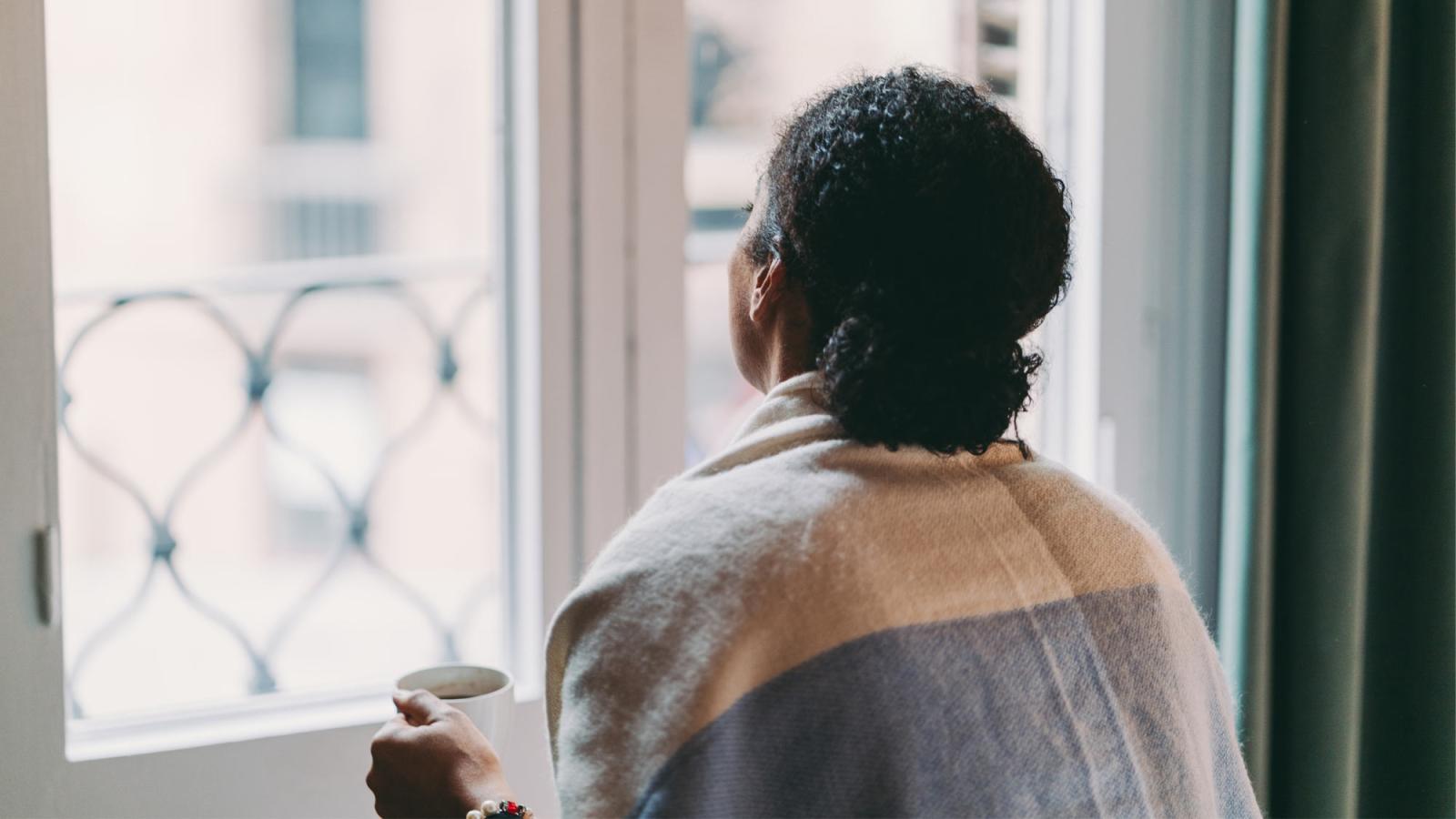
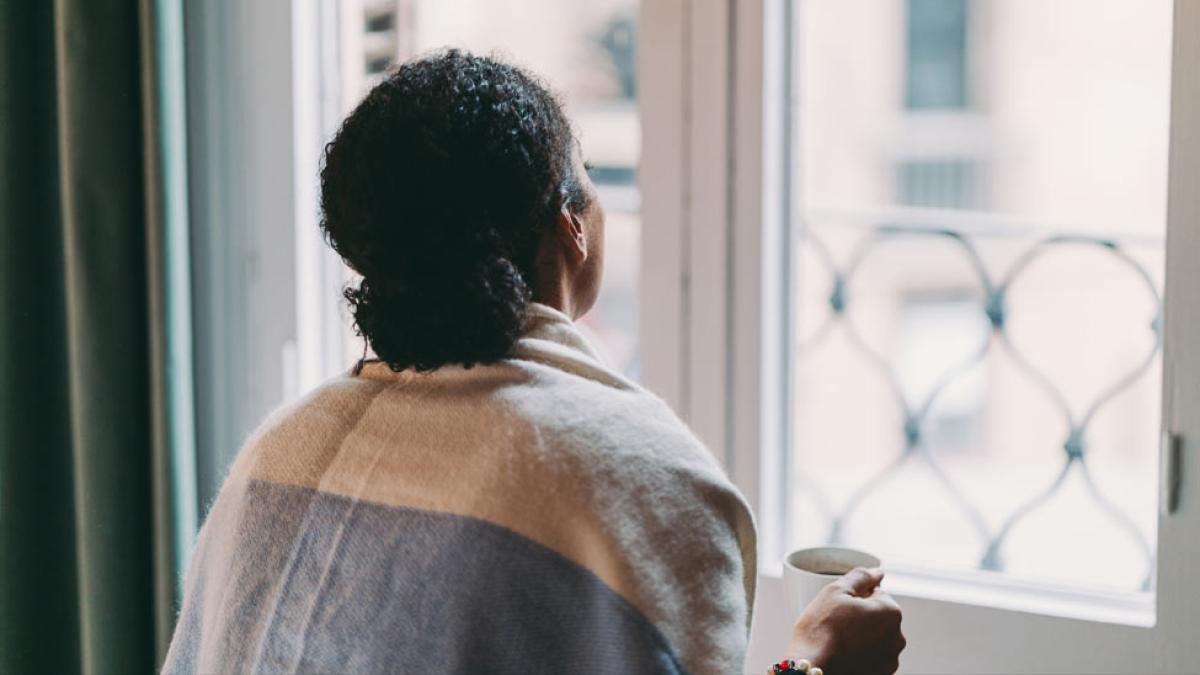
Psychology professor Anthony Mancini has an unconventional perspective on stress. “People assume that stress is always negative. But stress is actually more complicated than that.”
For example, the months following Hurricane Sandy in 2012 were extremely disruptive, filled with power outages, gas shortages, and many areas remaining closed. Even so, Mancini’s research into how Pace students were faring in the aftermath showed that they had lower levels of depression, better self-esteem, and more social support in the semester following the hurricane.
“Stress actually tends to stimulate social interaction, cooperation, and trust. The irony is that when something stressful or traumatic happens, you might actually end up better as a result. Obviously, that’s not always true. Trauma can also be very isolating, which is when PTSD happens. But ‘trauma’ is a very loaded word that’s lost meaning from overuse, making it harder to understand the different types and intensities of trauma as well as the difference in consequences.”
“The irony is that when something stressful or traumatic happens, you might actually end up better as a result.”
Mancini’s research focuses on those nuances. He’s particularly interested in uncovering how trauma and stress affect individuals, groups, and large social structures in order to determine why some are able to navigate through stress and trauma relatively well and end up functioning better as a result, rather than worse.
In his Trauma, Social Processes, and Resilience Lab, Mancini studies how people cope with and adapt to significant life stressors. In many universities, this kind of high-level original research is typically reserved for graduate and doctoral students. But Mancini says, “I’m always delighted when undergrads contact me. They’re motivated and curious, and I have them doing the same tasks as upper-level students.”
Mancini is currently writing a book—a hybrid memoir combining his own childhood experiences and the science of positive adversity. “I want people to know that adversity in childhood is not a life sentence; I find it objectionable that it’s portrayed that way, having had my own share. It’s not a good thing to tell children that they’ve been traumatized. Our psychological makeup is highly susceptible to influence. I don’t mean to dismiss that there is an impact with trauma, but it’s complex, and there are a lot of factors that go into determining the level and intensity of that impact. This book is an effort to tell the story and unpack and examine the assumptions about childhood trauma in light of scientific, empirical research.”
More from Pace
Through Digital Trash, an augmented reality art exhibit, Professor Will Pappenheimer and his mobile media students are elucidating an often-unseen problem in a truly innovative way.
Rhonda Miller, head of Pace’s BFA in Commercial Dance, wanted to build a different kind of dance program. “I wanted it to be relevant and useful—to include all forms of dance and the practical business skills dancers need but so often don’t have. We’re giving students the tools they need to navigate show business and make a living in dance.”
S. Brian Jones, Pace University’s assistant dean for diversity and equity in theater and media arts, wants young artists to stop waiting for someone else’s approval. He’s leading the charge in giving Pace students the tools they need to write their own success stories.
The Unstoppable Aman Islam
In his second semester, he interned for a Manhattan Borough President campaign. Last semester, he interned for Senate Majority Leader Charles Schumer’s district office. As a second-year student, Aman Islam is demonstrating what it means to be a go-getter, and he shows no signs of stopping.
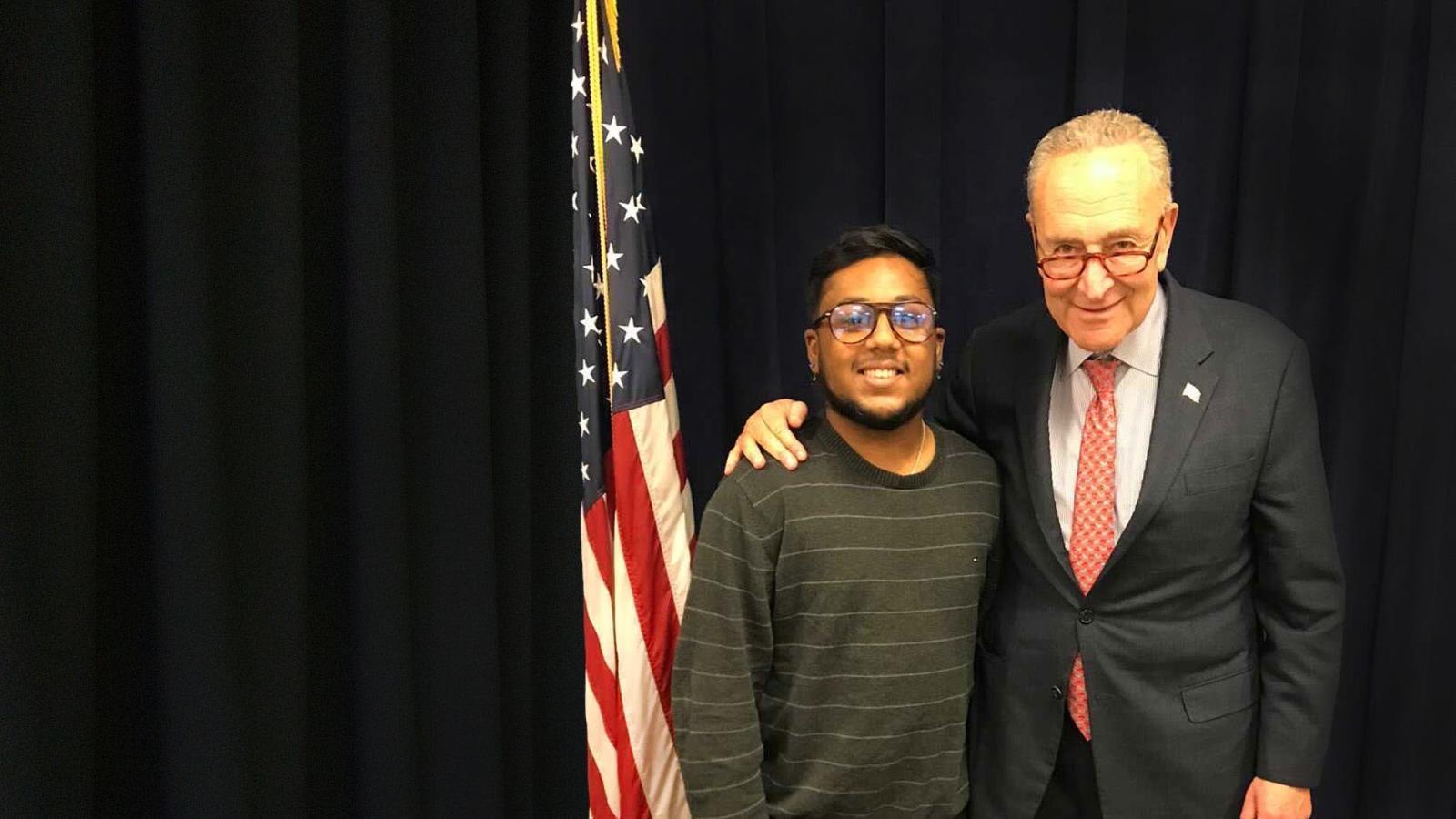

The moment Aman Islam ‘24 arrived at Pace, he was ready to get going.
As a second-year student, Aman has already built an impressive resume working on the campaign for Manhattan Borough President Mark Levine and interning for Senate Majority Leader Charles Schumer’s district office.
Speaking with Aman, you get the sense that nothing can slow him down. He even conducted our (virtual) interview through a case of COVID-19, waving a hand and saying, “I’m feeling better today.”
As a political science major, Aman wasted no time taking advantage of the opportunities you can only find in New York City. During his first year at Pace, he joined the campaign for Mark Levine as Manhattan Borough President and had the experience of a lifetime, saying, “It was probably the most influential thing I’ve done thus far. A lot of Pace students were on the campaign with me. It was all about building that organizing experience that is helping me to do other opportunities now.”
Opportunity begets opportunity and working on Levine’s campaign opened up the door for Aman to work in Leader Schumer’s office. Aman explains how a connection from Levine’s campaign introduced him to the internship. “Me getting that internship as a freshman helped me get this internship as a sophomore.” After a rigorous application process, he was chosen as an intern—and it was time to get back to work.
Of course, with an ongoing global pandemic, Aman and the other interns had to adapt. As an outreach intern, Aman spent his time reaching out to different organizations and coordinating virtual events for the Senator. Even in a remote environment, Aman gained unique insights into the dynamics of such an influential government office. “I really saw how politics and government are sometimes different,” he says.
“Me getting that internship as a freshman helped me get this internship as a sophomore.”
After months of working virtually, Aman finally met the Senate Majority Leader. He recounts, “I got to sit in a room with a whole bunch of people from different colleges around the city. Seeing myself there, in this coveted internship with people who go to Columbia and Princeton, just shows the opportunities you can get regardless of who you are.”
Currently, Aman is focusing on his studies, but is considering returning to the internship, and he (and Senator Schumer) both think more Pace students should apply. According to Aman, “The Senator said to me, ‘We need more Pace students like you to join the program.’”
Aman insists, “If you’re in the political science field, even as a freshman, go apply to these internships, because I had so many great opportunities thus far and I’ve built such a network among people in my field already. It’s super influential and it’s definitely going to get me places... The possibilities are endless now that we’re back in-person. Just go for it.”
More from Pace
From having an entire season cancelled to vying for the NE-10 Conference title, Pace Women’s Basketball has been making the most of their return to action. Coach Carrie Seymour and team co-captain Lauren Schetter discuss this year’s success amidst unorthodox circumstances, and reflect on Coach Seymour’s major milestone of 500 career wins at Pace.
Julia Sroczyk always dreamed of traveling to New York City. Through the Kosciuszko Foundation and the English Language Institute at Pace University, she was able to see her dream come true.
A Major Glow Up
Business students Ritvi Shah ’22 and Luanne Dinh ’22 talk about their experiences working with Pace’s Small Business Development Center and how they helped support New York City-based GLO Studio as it navigated the rough waters of business during a pandemic.


During the height of the pandemic, many small businesses struggled to pivot—making tough decisions that would ultimately impact whether their companies would sink or swim. For companies working with Pace, it was more smooth sailing than white water rapids.
GLO Studio, a women-owned and Lower East Side-based custom neon light studio, found itself in an interesting predicament during the height of the COVID-19 pandemic. When COVID-19 guidelines regarding non-essential businesses were implemented, GLO Studio had to temporarily close its physical storefront and studio space, forcing the business to transition to operating exclusively online with limited operational capacity. To say the least, the future was uncertain.
Enter Pace’s Small Business Development Center. Funded in part by the US Small Business Administration and the State of New York, the Pace SBDC combines the resources of Pace University, the private sector, and local/state/city government to enable small businesses to reach their full potential.
Through working with Pace’s SBDC, GLO Studio was able to do just that—namely, by turning the immense challenges of the pandemic into an opportunity.
When GLO Studio hooked up with Pace’s SBDC, they were not only able to get guidance on how to apply for financial assistance to support their business, but they were able to work with Pace’s up and coming business students. Two undergraduate consumer behavior classes, taught by Lubin Professor Mary Long, helped GLO Studio research changes in buyer behavior during the pandemic and in turn provide valuable insights and recommendations for business growth.
Ritvi Shah ’22, a Global Marketing Management and Finance major, was one such student that took up the challenge of finding dynamic ways for GLO Studio to adapt to running a business during a pandemic. She explains, “While working for GLO Studio, my team and I had our own roles according to our talents. My role was looking at social platforms the company was on and analyzing what could be improved on. I dug up information that even the company didn’t realize was available and presented it to GLO Studio.”
“Working on this project with a real business in NYC was a great experience. I was able to learn about the different nuances that come with running a business, and the cutthroat competition that exists in NYC.”
The opportunity for students to work directly with a real business was a major value add, not just in terms of hard skills and research, but the soft skills that only experience can really give. According to Shah, “Working on this project with a real business in NYC was a great experience. I was able to learn about the different nuances that come with running a business, and the cutthroat competition that exists in NYC.”
For Advertising and Integrated Marketing Communications student Luanne Dinh ’22, one of the most important things she learned was empathy and listening to her clients’ needs to help develop a strategy.
“GLO Studio was very adamant about their craftsmanship of neon lighting, even if that meant their prices were higher than their competitors,” explains Dinh. “Instead of suggesting to offer major discounts or lower their prices, we instead opted for an awareness campaign that would inform consumers why GLO Studio’s neon lights are more expensive—better quality, professionally installed. Essentially, turning their price into a benefit.”
With assistance from Pace SBDC Business Advisor Sandra Cely, GLO Studio was able to secure more than $200,000 in financial support through the federal Paycheck Protection Program (PPP) and Economic Injury Disaster Loan (EIDL) program, helping retain the venture's eight jobs.
For the students who worked on the project, the rewards of working with the SBDC and GLO Studio helped create new opportunities and possibilities for their own futures.
“Working with GLO Studio was a great way to challenge myself. Rather than simply reiterating what I was learning in class onto a piece of paper, I was able to apply what I had learned,” says Shah. “I was able to see how extensive my academic and professional capabilities were when I put in the hard work. I found ways to research other than the conventional Google search and clicking on the first thing that I popped up. Instead, I dug deeper to find problems that lay within the organizational structure that caused core problems.”
In the future, Dinh, who currently freelances as a brand designer for an Aruban coffee shop, hopes to turn her work into a full-fledged design company.
“In the future, I would definitely consult Pace SBDC for starting my own business,” she says. “Every student should get a chance to work with a real client, it is extremely rewarding to see your strategies create positive changes in a real business.”
More from Pace
In his second semester, he interned for a Manhattan Borough President campaign. Last semester, he interned for Senate Majority Leader Charles Schumer’s district office. As a second-year student, Aman Islam is demonstrating what it means to be a go-getter, and he shows no signs of stopping.
Through Digital Trash, an augmented reality art exhibit, Professor Will Pappenheimer and his mobile media students are elucidating an often-unseen problem in a truly innovative way.
Internet addiction, the rise of esports, and stigma surrounding digital gaming in China. Pace professor Marcella Szablewicz examines how new communication technologies impact a growing culture shift.
Pace BLSA Mock Trial team places first in 2022 Constance Baker Motley Mock Trial Competition
The Pace BLSA Mock Trial team attended the 54th Northeastern Black Law Students Association Convention and placed first in the 2022 Constance Baker Motley Mock Trial Competition. In four back-to-back rounds, the Mock Trial team edged out multiple law schools in the Northeast region. This year’s team included students Laura Felix, Nechelle Nicholas, Juan Rodriguez, and Naja Williams. Professor Betty Lewis coached the team. For months, a shadow team prepped alongside the competition team, consisting of students Katherine Boyd, Idalis Davis, Derek Segars, Aaliyah Smith.
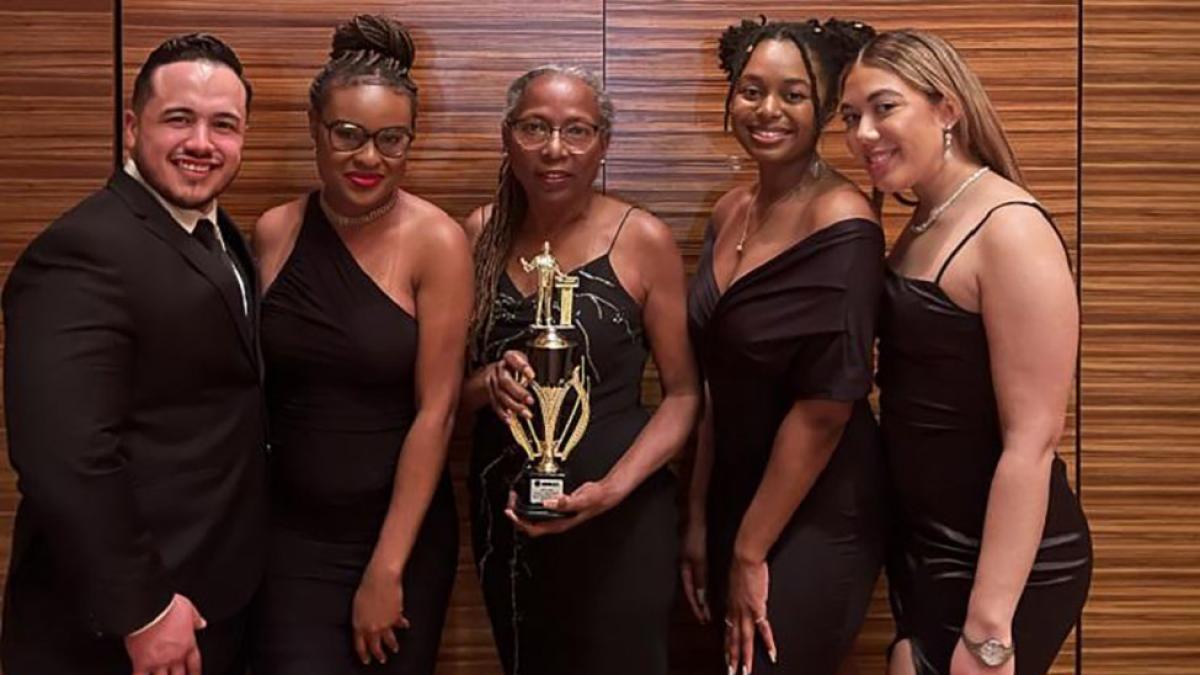
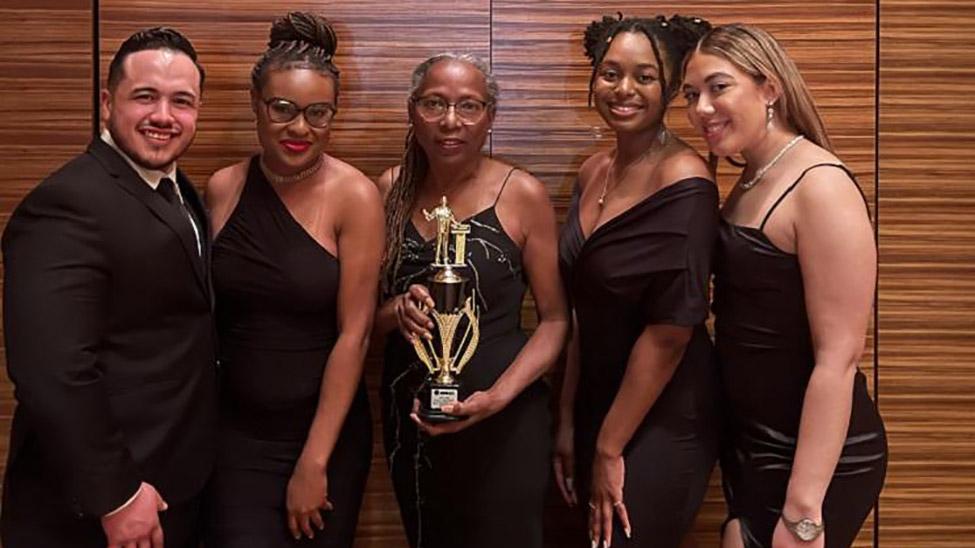
The Pace BLSA Mock Trial team attended the 54th Northeastern Black Law Students Association Convention and placed first in the 2022 Constance Baker Motley Mock Trial Competition. In four back-to-back rounds, the Mock Trial team edged out multiple law schools in the Northeast region. This year’s team included students Laura Felix, Nechelle Nicholas, Juan Rodriguez, and Naja Williams. Professor Betty Lewis coached the team. For months, a shadow team prepped alongside the competition team, consisting of students Katherine Boyd, Idalis Davis, Derek Segars, Aaliyah Smith.
Competitor Nechelle Nichols stated, “We have been preparing vigorously for the past four months and honed our trial skills. Every single team member stepped up to the plate, and that is what ultimately allowed us to think quickly on our feet, sharpen our acting skills, make multiple changes to our strategy, and deliver passionate arguments. Placing first in the Northeastern region in a competition named after a trailblazer who we each aspire to be like, and moreover, being a part of a convention which brought Black law students together was a true honor.”
Educator Moves: Shifts in the Dance Education Landscape From Winter 2021–22
Jennifer Holmes has been named executive director of Pace School of Performing Arts at Pace University.
Senator Pete Harckham Tours Pace University's Nursing Labs
Pace University hosted New York State Senator Pete Harckham on a tour of its clinical simulation labs and held a roundtable discussion on addressing New York's critical need for nurses and other primary care professionals. In visiting Lienhard Hall, home to Pace's College of Health Professions and its Lienhard School of Nursing, Harckham joined faculty, staff, and nursing students – all of whom shared their experiences in the field and discussed ways to address the nursing shortage and expand the healthcare worker pipeline, a staffing issue that has been exacerbated by the COVID-19 pandemic.
Mobilizing Healthcare Education to Solve Worker Shortage
Four nursing students intently observed fellow students practice special care on a full-body manikin with real body functions in a simulation at Pace University last Thursday. Also watching the exercise in the fully-equipped exam room at the university’s College of Health Professions in Pleasantville was state Sen. Peter Harckham (D-Lewisboro), who toured the college’s clinical labs to become better acquainted with how the healthcare workforce is educated, crucial to recruiting more workers into the medical profession.

The Key to Sustainable Investing That's Good for the Planet? Homework
“We all want that triple bottom line: people, planet and profits,” says Steve Mezzio, a long-time proponent of sustainable investing, and executive director of the Center for Sustainable Business at Pace University’s Lubin Business School in New York. “The problem is you want to do good, and at the same time, you want to make money.”

Elisabeth Haub School of Law at Pace University hosts prestigious 34th annual Jeffrey G. Miller National Environmental Law Moot Court Competition
Instituted in 1989, the Jeffrey G. Miller National Environmental Law Moot Court Competition (NELMCC) is one of the nation’s largest interschool moot court competitions. Under pre-pandemic conditions, NELMCC is known for hosting as many as 350 law students and attorney judges on the Elisabeth Haub School of Law at Pace University’s Westchester campus. Despite the pandemic, last year, Haub Law did not skip a beat and hosted the first ever all virtual NELMCC – allowing students to continue to participate in the highly competitive competition. This year, still in the midst of the COVID-19 pandemic, the Competition was held virtually once again.
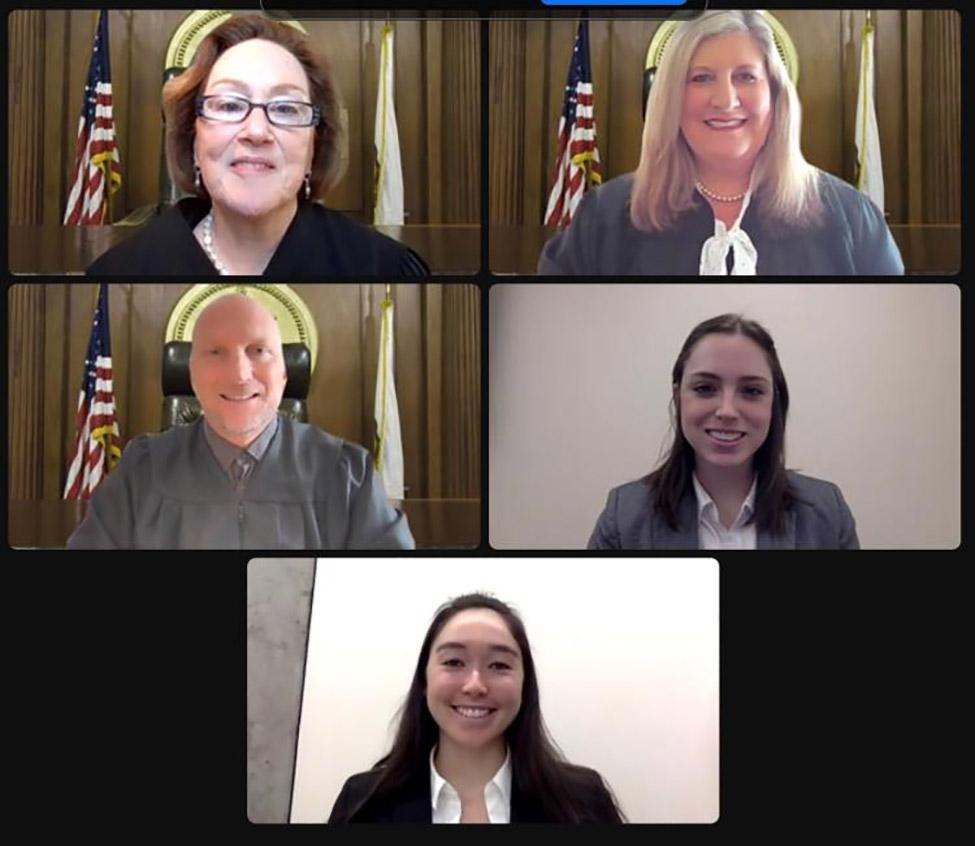
Instituted in 1989, the Jeffrey G. Miller National Environmental Law Moot Court Competition (NELMCC) is one of the nation’s largest interschool moot court competitions. Under pre-pandemic conditions, NELMCC is known for hosting as many as 350 law students and attorney judges on the Elisabeth Haub School of Law at Pace University’s Westchester campus. Despite the pandemic, last year, Haub Law did not skip a beat and hosted the first ever all virtual NELMCC – allowing students to continue to participate in the highly competitive competition. This year, still in the midst of the COVID-19 pandemic, the Competition was held virtually once again.
NELMCC has established a national standard of excellence in moot court competitions. Each year the “Problem” presented to the teams focuses on timely issues of national importance to the practice of environmental law. This year, Professor Karl S. Coplan challenged both teams and judges alike with a unique, timely, and complex “Problem” focused on the Clean Water Act. Assisting in editing this year’s “Problem” and writing the Bench Memo, was Haub Law Environmental Fellow, Katie G. Horner. Chaired by a Haub Law student each year, this year, Haub Law 2L Christen T. Maccone had the honor and responsibility. Prior to the Competition, competitors research and analyze the issues presented in the environmental problem before writing persuasive arguments for one party (either the government, a public interest group, or a member of the regulated industry) advocating how the issues should be resolved. Competitors are then required to argue the issues orally for all three parties, rounding out the rigorous academic experience.
Associate Director of Environmental Law Programs at Haub Law, Achinthi Vithanage, noted, “Students participated from around the country, from Hawaii to Florida, and so did judges, with some even joining us internationally. I am pleased to say that 51 law schools competed and over 300 students, coaches, and judges participated this year. Many of our judges included Haub Law alumni who have been returning for over 20 years as volunteers.”
The preliminary, quarterfinal, and semifinal rounds were held virtually on Zoom on Wednesday, February 23, Thursday, February 24, and Friday, February 25. The final round took place on Saturday, February 26 and was presided by three judges: Alexandra Dapolito Dunn, Baker Botts LLP, Judge Mary Kay Lynch, EPA Environmental Appeals Board, and Professor James R. May, Visiting Professor of Law, Elisabeth Haub School of Law at Pace University (2022).
Finalist teams included, Duke University School of Law (Maia Foster, Zoe Gabrielson, and Mikaela Johnson), Lewis & Clark Law School (Haley Nicholson, Kassie Kometani, and Matthew Campa), and Stetson University College of Law (Lauren Beames, Emily Witthoeft, and Mia Hartley). After the final round, the esteemed judges gave excellent critique and feedback to all teams. Ultimately, taking first place for the 2022 Competition as the winning team was Lewis & Clark Law School.
The Jeffrey G. Miller National Environmental Law Moot Court Competition is grateful to the organizations and people whose generous financial support help make the event possible. This year, we were pleased to have the following major supporters: The American Bar Association (ABA) Section of Environment, Energy, and Resources (SEER), Baker Botts LLP, and Riker Danzig, Scherer, Hyland & Perretti, LLP.
